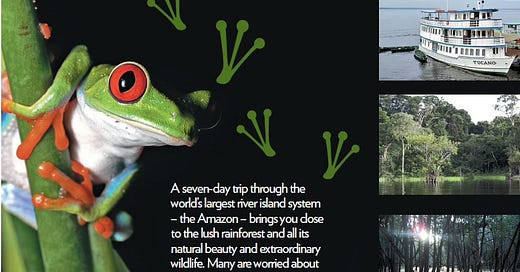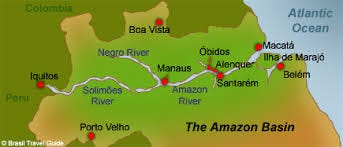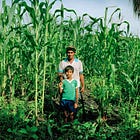Hola Amigos! In 2008, I cruised the Amazon on a 90-foot 19th century replica of a Brazilian riverboat for seven days. The journey began in Manaus, a Covid hotspot years later in 2020 and one of the world's hardest hit areas where mass graves were needed due to the high death toll. This article first appeared in the Sunday Living section of The News, Mexico City, June, 2008: Up the Rio Negro, Down to the Amazon. Partial cover pictured above.
I sat with Edivan, one of our two jungle guides, inside the sunny, wood-paneled salon of the Motor Yacht Tucano, an elegant 90-foot, nine cabin replica of a 19th century Brazilian riverboat, and watched lush, pulsating rainforest float by as we headed up the Rio Negro.
Last outpost of civilization
We were cruising through the world's largest river island system, the Anavilhanas Archipelago in the heart of the Amazon, the lungs of our planet, and by mid-afternoon we'd be well past Manaus, Amazonas, a former frontier settlement with a population of 1.5 million, known as the last outpost of civilization.
“Is there hope for the future of the rainforest?" I asked the serious, competent man who would show the 12 of us on board both the obvious and hidden beauties of the vast ecosystem we were entering.
"That's like asking do you believe in God?" he countered. "You've got to have faith in something. Me, I have faith in the forest but I believe it can get better. We can get better. But people's ignorance always gets in the way.
"Today everyone is more worried about the state of the forest, not just for the trees, but for its food, its oil and it's vegetables."
"I read in 2003, 150,000 square kilometers of Amazon's rainforest disappeared, about the size of the state New Hampshire. Is that still happening?"
Rubber and soy
“Because of globalization,” Edivan continued as a shadow crossed his face,"we are all merged together. The future looks very dark but many things are happening. Before, the problem was rubber."
“Like with Chico Mendes?” I asked. "The environmentalist who stood up to the rubber industry when 180,000 rubber trees were destroyed along with a million valuable hardwoods?"
“In 1988 Mendes was murdered for his beliefs," Edivan said. "Now it's not the rubber industry. It's not even cattle ranching. Now the threat is soy. If anyone stands up to the soy producers, they will die."
He sweeps his hand past the finely crafted mahogany windows toward the translucent green forest and that dark, flat river,
“See how thick the forest is? The Rio Negro, this part of the Amazon, has heavy sediment from falling leaves which creates a high pH balance and turns the water black. It makes it hard for life, for fish, to survive, unlike the Amazon where everything thrives. Maybe a thousand people live in this large region. Maybe. I don't think they can bulldoze it down here." Finally I saw the possibility of a smile.
I gazed out at 150-foot high trees. They're staggering in height although in reality, I thought they'd be taller. I was told by Aguimaldo, our indigenous guide, that farther inland, they are. Anything you can see from shore has already been cut, so this could be second or third generation growth.
Heart of the Amazon
My dialogue with Edivan continued on this seven-day journey into the heart of the Amazon. Daily we divided into two groups, climbed into outboard rigged wood canoes and took excursions up small tributaries and canals off the Rio Negro. We saw ringed kingfishers, pink dolphins, blue macaws, red macaws, white-throated toucans, three-toed sloths, squirrel monkeys, green ibis, reddish egret, wattled Jacanas, black nun birds, Amazon kingfish, yellow cacique, puffbirds, black collared hawks, white-tailed trogons, and crimson topaz hummingbirds. For starters.
We took forest walks wearing leather leg chaps from knee to ankle for protection against snakes. We saw buttressed trees, bullet ants, medicinal plants. We met a subsistence farmer and his wife who grow manioc root and process it into tapioca. We stopped at a boat building factory in a local village where the Tucano was built ten years ago. We saw the flooded forest where water levels will rise 20 feet in just a few months. We sat in canoes at dawn to watch the sun rise over the river. Occasionally we would get caught in a light, tropical rain storm.
In between excursions we came back to the boat to eat incredible food prepared by Gemma and Angelina, our cooks, from the smallest most cramped kitchen you can imagine. The dining room buffet at meal times overflowed with fresh salads and fruits—some which I hadn't seen before—along with rice and beans, vegetables, chicken, occasionally a meat dish, and always a spectacular freshly caught fish.
The desserts make me gain weight by proxy. Even at breakfast there's cake on the table and at dinner, not only cake but a Brazilian custard made with papaya, coconut, pineapple, or crème brulée or flan. Some nights a tasty dessert was conjured from manioc root, the food staple which takes shape in everything from cakes to breads. And no meal was complete without fresh squeezed juice.
Welcome to the Amazon
We'd landed in Manaus in the heart of the Amazon rainforest to begin this journey in late January. Copa Air dropped us from Miami into a small, dilapidated airport where one unruffled immigration officer diligently stamped tourist visas.
On the side of the runway, four vine-covered DC 10s languished in various stages of mold and decay, a startling example of nature at work. Welcome to the Amazon.
The Motor Yacht Tucano river trip would combine the best elements of the Rio Negro for 300 kilometers north before heading back to the Amazon, or Solimoes River, as it's known to the locals, where we'd see the confluence of the waters.
The Rio Negro's black water converges just outside Manaus with the white or café au lait colored Amazon. It's a spectacular sight, this distinct color variation that stretches for seven kilometers.
I'd researched the trip intensely before deciding on the Tucano. It was either that or a people's ferry. I’d read the guidebooks and they all assured me I'd have everything stolen on the ferry plus I'd have to sleep in a hammock, possibly on an open deck with strangers. No. No. No. Twenty years ago I wouldn't have given it a second thought, but this was now.
Hotel Tropical
We arrived a few days early and checked into Hotel Tropical, a well-preserved, gentile grandy with 600 rooms a giant sprawl across one floor, 13 kilometers from Manaus. Towering tress surrounded walled gardens that circled the hotel. Our drive passed the hotel zoo, the tennis courts, the carefully marked trees, on a wide asphalt road. I spot white columns rising over a sweeping entrance. Inside, a 40-foot atrium adjoins a long L-shaped reception desk. Heavy dark woods prevail along with high-vaulted ceilings. I'm ensconced in my favorite type of luxury—colonial turn-of-the-century in a jungle setting. Heaven.
In Brazil, size is not an issue: Everything is huge. We walk what seems miles to our room past rows of substantial mahogany doors. The bellman shows us into an attractive 30 x 40 foot suite with French doors overlooking a terrace. Dark wood trim adorns all closets and mirrors as does the Brazilian granite—Jacinta, speckled grey-rose-black—that I will soon identify in every bathroom, every bar, every countertop throughout the country.
At this point I still haven't seen the water flush the opposite way as I've heard it does in the Southern Hemisphere. The hotel has low flow toilets but not so for the shower. With the mighty Amazon just 200 feet from our terrace, the shower blasts me with the force of a fire hose, pressing me against the glass wall and filling the stall so quickly I turn off the faucet so the drain can catch up. We languish in this gracious spot two days before boarding the Tucano.
You can’t pick your neighbors
"Do you know what an alligator feels like? It feels like a purse, ha ha," laughed one of the less lustrous of our travel companions. "Or a pair of boots."
Thank God there were ten others who could drown out this cretin's personality disorder. On booking the cruise, my main fear was the human factor—not snakes, piranha, or jaguars. I feared the species Americana Erectus—the strident mouthpiece I seemed to never avoid, even by moving to Mexico. After a few days I removed myself from conversations and sought solace and found it. In the upstairs deck.
Upstairs deck
Painted spic-and-span white and peppered with lounge furniture I enjoy the balmy breezes and near 360 degree views of river and forest. Mornings find the river flat as a lake and Dante Inferno red. The perfectly mirrored reflection of trees in the water is apparent even under cloudy, mottled skies. From my vantage point I see a half moon of green wild rice, shockingly florescent in color, like a stubbled layer of beard on a man's chin. I hear a flock of scarlet macaws jabbering in the distance long before I see them; their brilliant feathered bodies jettison out of faraway trees, all the while squawking incessantly.
I rejoin the group for most outings but now I've located my escape hatch and retreat back to it a few more times before the journey's end. Our last day is spent on the Amazon at the confluence of the waters. We're two degrees off the equator and a full moon rises that night in the tropical sky. Gazing out at large container ships far in the distance, I'm glad I could take this journey into Amazonas, a place that is far from fully explored, where there is more Amazon rainforest and indigenous people than any other place in Brazil.
On Fire: Rainforest Update
Jair Bolsonaro’s presidency in Brazil beginning 2019 took immediate steps to weaken environmental enforcement prompting a boom in logging. A Reuters news agency witness traveling in southern Amazonas state during August 2021 saw massive fires billowing smoke miles into the air with the haze blanketing the landscape. Fires were often near the edge of cattle pastures, and much of the burned land would likely become pasture. According to a draft of a landmark study compiled by 200 scientists published July 2021, cattle ranching is the main driver of deforestation.
Brazil's National Institute for Space Research exposed over 65,000 fire hotspots at the end of August 2024—the highest number for this period since 2005. In 2024 a record 62,000 square kilometers burned (think Costa Rica) and is now itself emitting record amounts of carbon dioxide.
The fires are a direct result of soaring deforestation, often carried out to illegally claim and clear land for farming and agriculture.
People ask, what year will the Amazon rainforest be gone? With the current rate of deforestation, the world's rainforests will be gone by 2100. The rainforest is home to more than half of all species on Earth. Deforestation comes first, fires follow.
The Amazon rainforest, known as the lungs of our planet, is the world’s largest.
If you’re interested in supporting well-researched and thoughtful writingand you’ve been enjoying my posts and are in the mood to be generous, your paid subscription would make my day. Keep up to date on Mexico, travel, chapters from Where the Sky is Born—how we bought land and built a house on the Mexico Caribbean coast. And opened a bookstore, too! All for $5/monthly or $50 per year.
Hit the heart at the top of this email to make it easier for others to find this publication and make me very happy.
Backstory—Puerto Morelos sits within 100 miles of four major pyramid sites: Chichen Itza, Coba, Tulum and Ek Balam. By living in close proximity to this Maya wonderland we pyramid hopped on our days off from Alma Libre Libros, the bookstore we founded in 1997. Owning a bookstore made it easy to order every possible book I could find on the Maya and their culture, the pyramids, the archeologists who dug at these sites and the scholars who wrote about them, not to mention meeting archeologists, tour guides, and local Maya who popped into the store. I became a self-taught Mayaphile and eventually website publishers, Mexican newspapers and magazines, even guidebooks asked me to write for them about the Maya and Mexico. I’ll never stop being enthralled by the culture and history and glad there’s always new news emerging for me to report on right here in Mexico Soul. Please share this post if you know others interested in the Maya. Thank you!

















Thanks for restocking, Joyce!
OMG, Jeanine, this is a wonderful article full of great insights. I wish I could add this river trip to my bucket list, but it would be too strenuous for me. Fortunately, I can enjoy the trip through your article. Best regards.